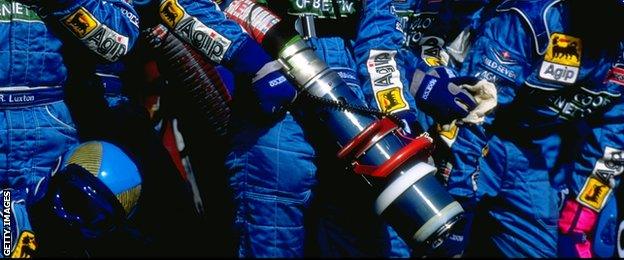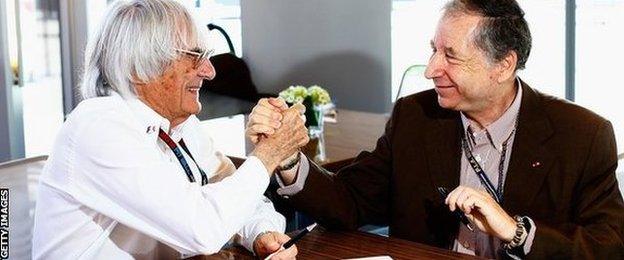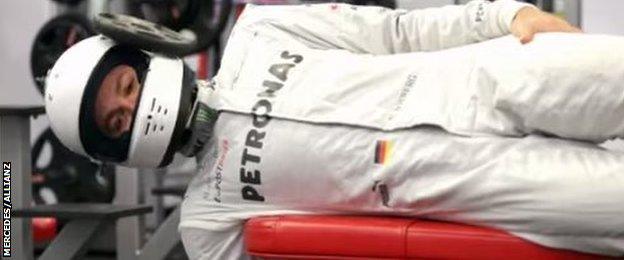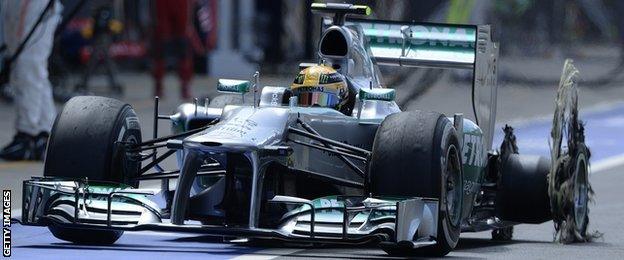The truth behind why Formula 1 is so difficult to manage
- Published
- comments
Formula 1 is changing. The sport's bosses are in the process of creating new rules aimed at ensuring the cars that race in 2017 will be the fastest ever.
The motivation for this has been concerns that F1 is losing its appeal, a belief created by falling television figures last year in some important markets, such as Germany and Italy.
Commercial boss Bernie Ecclestone, governing body the FIA and the teams have decided to leave aside for now the question of whether the falling figures are a reflection on F1 itself, or of a splintering TV market, and take action.
The result for F1 is going to be a very different sport in 2017, when most of the changes will come into force.
So why is F1 taking the decisions it is, and what difference will they make?
Refuelling

Equipped with a large extendable hose, pit crews stood by ready to refuel, as demonstrated here by the 1999 Benetton team
There was some dismay among F1 bosses when the media focused on the decision of the rule-making strategy group two weeks ago to consider the reintroduction of refuelling in 2017, rather than what they believed was the more fundamental commitment to make the cars five to six seconds-a-lap faster.
Part of that was down to the communication of the decision. An official statement by the FIA presented refuelling as a done deal - only for Mercedes F1 boss Toto Wolff to explain a few hours later that it was only a proposal.
Less than a fortnight later, that proposal is looking very shaky indeed, as not one of the teams wants refuelling to happen.
All realise that, as one team boss put it, "refuelling is not good for the spectacle". While it will also add up to a million euros to each team's costs because of increased freight bills.
But the idea is not dead yet.
The teams' sporting directors have been mandated to explore the issue fully. Having met in Monaco last weekend and established the extra costs involved, they will reconvene at the next race in Canada to explore its effect on the show, having looked at the data.
They already know the answer. The data shows that all the refuelling years of 1994-2009 had fewer overtaking manoeuvres on track than any other season since 1980.
In the first year after refuelling was abandoned, 2010, the number of overtaking moves more than doubled compared with 2009. That number then nearly tripled in 2011, when Pirelli tyres and the DRS overtaking aid were introduced.
Whether the sport's big bosses will pay attention to these figures is another matter, though.
The idea was proposed by Donald MacKenzie, chairman of CVC Capital Partners, the main shareholder in the company that runs the commercial side of F1. It won support from Ferrari president Sergio Marchionne. It remains to be seen whether they and Ecclestone will be swayed by the data.
The fastest cars ever
One of the continuing complaints of F1 drivers about their cars is that they are too slow and, as a consequence, the challenge of driving them has been reduced because they are less physically demanding than in the past.
This is only partially true. Mercedes executive director (technical) Paddy Lowe says the cars of 2015 are "close to historical highs in both power and downforce". And this year's cars are approaching the ultimate lap times of those of 2004, which hold nearly all the records.
However, this is only the case in qualifying. In races, drivers do have a point; modern cars are as much as 10 seconds a lap slower than those of a decade ago.
Partly this is to do with the fact that there is no refuelling, so cars are much heavier at the start of races. The rest of the reason is to do with tyres, which we will come to shortly.
F1's bosses do accept, though, that the the current cars need to be faster to distance them from those of the GP2 feeder formula.

Despite criticism from fans over the years, Bernie Ecclestone retains strong relationships with the FIA's chairman, Jean Todt (right) and drivers
Because of this, for 2017, some things are already pretty much set in stone:
-cars will be widened from 1,800mm to 2,000mm
-rear tyre width will be increased from 325mm to 420mm
-front and rear wings will be made bigger
-aspects of the underbody will be changed to increase downforce generated beneath the car
-overall weight will be reduced
-driver aids will be removed, among them almost certainly power steering systems
Widening the cars will speed them up by a second a lap. Another second can be found by reducing the car's ground clearance.
Add in the wider tyres, tweaks to the wings, and taking perhaps 50kg or so off the overall mass and those five or six seconds are found relatively easily.
That in itself will automatically make the cars more demanding physically for the drivers.

Drivers such as Nico Rosberg developed training techniques to strengthen their neck muscles. This was to cope with large amounts of G force within the cockpit
Lowe says: "If we go four or five seconds a lap quicker, there is a human bandwidth aspect to that. You may well find that at a lot of circuits - and Monaco will be one of them - the lap time you do is a function of control and physical limits of the driver and not the car limit, and therefore not the tyre limit."
Some question the wisdom of making the front wing wider. That's because it is believed that the more a car depends on its front wing for downforce, the harder it is for a driver to follow another car closely.
But this misunderstands both the findings of a body called the Overtaking Working Group, which studied these effects in the mid-2000s, and also what is planned.
The OWG found that it is the central part of the front wing that is first affected by 'wake' - turbulent air produced by a car in front. The closer the car gets, the more that effect moves outwards along the wing.
The rear wing of the car in front creates turbulent air. But if the rear wing is narrow enough, this only hits the central part of the front wing. The downforce-creating end areas actually suck in 'fresh' air from the sides.
So if the new rules increase the size of the current 500mm 'neutral' area in the middle of the front wing, which creates no downforce, and move the ends further out, it should in theory make it easier for cars to follow each other.
Tyres and wheels
Tyres are a thorny subject in F1 right now, because more of the viewing audience is waking up to the fact that the nature of the Pirelli tyres means the drivers are hardly ever driving at the limit in races.
This raises a philosophical question about what F1 is. And another about what its stakeholders want it to be.
Red Bull team boss Christian Horner describes F1 as "entertainment". But many would say it was a sport which, in an ideal world, would be entertaining. Where you stand on that very much affects what you feel about the tyres.
The drivers are cautious about what they say publicly, out of a desire not to get into trouble for saying the wrong thing. But to a man they would like to have more durable tyres on which they could push hard all the time.

The current Pirelli manufactured tyres have been under scrutiny from drivers for their lack of durability, but it is their width that will make the difference to the speed and overall performance of the cars
The Pirellis are not like that, as one senior engineer who asked not to be named explains: "There are two aspects to it. The first is the fact these tyres do actually run out of rubber. There is a point where the driver will say: 'I'm coming in, the tyre's finished.'
"If you look at a degradation curve, it will have a distinct kink in it, when the tyre will actually run out. I don't think that was such a strong feature in the past - the tyres just carried on and got slower and slower and slower.
"The second aspect is that if you push them hard, you pay the price. They degrade consistently, but that assumes you are managing them. Whereas if you mismanage them you will get something dramatically worse than that curve.
"So, for example, the first couple of laps out of the pits are important to sort of bed the tyres in and get the life out of them. You can easily wreck a set of tyres on those laps. Whereas in the past you would have been right on the ragged edge straight out of the pits if that's what you needed to do."
To a purist, this is anathema; an F1 driver should be flat out all the time, no matter what.
Create a tyre that does that - by, for example, asking Michelin to be the new tyre supplier from 2017 - and the cars would undoubtedly be much quicker, to the tune of three seconds a lap just from the tyres, according to leading engineers.
However, there would also be far fewer pit stops. And pit stops are regarded by many senior figures as crucial to the show.

During otherwise uneventful races, pit stops add the drama the audience want to see
Equally, as another engineer puts it: "Because you have these more extreme degradation characteristics, you end up with people on different strategies. And when they interact they tend to have much bigger performance differentials. That's why the number of overtakes occurring in races has dramatically increased since Pirelli came into the sport."
This - and the fact that Pirelli pays handsomely for trackside advertising - is why Ecclestone has made it clear, external to teams that, as far as he is concerned, Pirelli will get the new contract, even though the FIA is running a full tender process and is expected to invite Michelin to apply.
Beyond that, there is the question of wheel sizes and lower-profile tyres.
Michelin says it would only come into F1 if wheel diameters increased to 18 inches from the current 13, to make them more relevant to modern, low-profile performance road tyres.
But 18-inch wheels and tyres are much heavier. Low-profile tyres are also slightly slower, because they have lower levels of peak grip.
And that's not good when you're trying to speed the cars up by making them lighter.
- Published1 June 2015

- Published31 May 2015
- Published1 June 2015

- Published1 June 2015

- Published18 December 2015

- Published2 November 2018

- Published26 February 2019
